Genre: Platformer Developer: Eurocom Ent. Publisher: Playmates Players: 1 Released: 1995
When Earthworm Jim hit the 16-bit machines in 1994, it was practically showered with critical acclaim. The action-platformer about an Earthworm-in-Power armor-superhero and his adventures in a zany universe turned out to be a hit across all the major platforms, be it the Genesis, the Super Nintendo or even on PCs running Windows 95. After making several game-of-the-year hit lists, it was pretty much a given that in order to capitalize on its success, developer Shiny Entertainment and Publisher Playmates would also port the game to the handhelds of the era.
For those who haven’t heard of Earthworm Jim, well, you obviously haven’t witnessed the nineties, so welcome to the site, kid. In short, in Earthworm Jim you take on the role of the eponymous hero, an Earthworm clad in power armor, who rides through space on his trusted pocket rocket and uses a plasma gun as main weapon but can also utilize his wormy body as a whip. Among his colorful foes are such characters as Evil the cat (ruler of heck, a place where people are tortured by demon specters, lawyers, fire-breathing snowmen and elevator music), The nefarious Space pirate and enemy to all earthworms Psy-Crow, Goldfish bob (who is literally just a goldfish) and Queen Pulsating, Bloated, Festering, Sweaty, Pus-filled, Malformed, Slug-For-A-Butt (or just Slug-For-A-Butt in shorthand), all of whom are after Jim’s power suit. Jim himself meanwhile sets out across the universe to meet the most beautiful creature of all, the lovely Princess What’s-Her-Name. So yeah, the game doesn’t take itself all that serious, but that’s part of its comic charm.
Of course, this raises an important issue. Aside from the zany premise the key assets in Earthworm Jim’s success were tight and versatile gameplay, the amazingly fluid and colorful animations, and the great Tommy Tallarico soundtrack. Would these elements make the transition to 8-bit intact? As the story goes, studio head David Perry himself promised to head the quality assurance efforts to make sure the port would be of the highest quality.
And to be fair, the game animates surprisingly well. Sure, mostly due to memory constraints, the idle animations as well as certain frames of enemy sprites had to be dropped. But aside from that, out hero Jim moves and controls very fluidly, especially for a Game Gear game. So, running, jumping and even head-whipping all work pretty well. The overall visuals are a bit lacking though, since they are missing their backgrounds and some detail, which is most notable during the first and the last stages of the game. Also, due to the different screen size and resolution, Jim fills a bigger portion of the screen, which may lead to certain issues. More on that later.
Speaking of head- whipping, therein lies a problem of its own: On the Genesis, whipping, shooting and jumping were spread over the usual three controller buttons. Since the Game Gear only has two of those however, the controls had to be laid out differently. Tapping button 1 now stands for a whipping attack, while holding down the button allows Jim to shoot. This means, however, that shooting can only be done with a slight delay. Also, the game can be a bit finicky in interpreting whether the player wanted to whip or shoot, which can be a problem in tight situations. Button two is for the jumping and the “helicopter” maneuver. Rapidly tapping the jump button makes Jim rotate his head wildly and thus float a bit, a skill highly necessary for survival during the last stage of the game.
Other than the slight change in controls, the game follows its 16-bit role model extremely closely, almost to a fault, in fact. The existing stages follow almost the same layout of their 16-bit counterparts (by the way, sorry for constantly referring to the 16-bit version during this review, but it is very apparent that the developers did so as well during the creation of the game). Of course, again due to space constraints, not all levels made the transition: Of the original’s eight levels, only five made it into the Game Gear version: Junkyard City, What the Heck, Down the Tubes (again split into two parts, with the second being called “Pod Race” here), and the final stage, “Helicopter” (Buttville in the Genesis version). Which, in my eyes, is kinda disappointing: The annoyingly long and difficult second part of “Down the Tubes,” where you need to traverse a narrow underwater passage in a dangerously breakable mini sub under a very tight time limit – one of the most infuriating bits of the original game – was kept in, while some of the more interesting stages (like level five) were cut out entirely. At the stage controls relatively well, but it is still every bit as hard as before, teeth-gnashingly so in fact.
In between each of the major levels, Jim races Psy-Crow through an Asteroid field in the “Andy Asteroids” mini-game. These stages play surprisingly well, though they seem to last a bit longer than in the Genesis version, which may not be to everyone’s linking. Here, you have to avoid all obstacles (brown asteroids that damage you) while reaching the end of a large tube before your rival. Collecting flaming spheres give you a speed boost, while getting 40 blue spheres grant you a continue. Shields can be activated manually and grant protection against the asteroids, though the time of invulnerability seems significantly shorter here. Lose the race and Psy-Crow forces you to land, whereupon you need to face him in a one-on-one battle. The plus side of this is that during the battle you’ll probably hear the only original track of music created for the Game Gear version. Either that, or the original track has been watered down so much that it became unrecognizable in the process. Honestly, I couldn’t tell.
While the visuals work for the race sequences, the fact that Jim takes up more screen space during the regular stages can lead to another problem: Flying enemies (like the crows in stage one or the demons in stage two) tend to blindside you suddenly attacking from off-screen, which is hard to avoid, especially with the delayed shooting controls. Also, invulnerability after being hit lasts only a minuscule time, so flying enemies can wreck you up faster than you can say “Whoa, Nelly!” It’s in times like these when I wonder whether adapting the stage layouts and enemy placements more to the Game Gear’s capabilities wouldn’t have been the better option rather than trying to painstakingly recreate the original levels in 8-bit. One thing the visuals are absolutely missing, though, is a clear indicator whether or not you’ve actually hit anything when you shot at an enemy. The sprites aren’t flashing, nor is there any other form of optical clue, which often leaves you guessing whether or not you’re successful in fending off your foes. At least during the first and second stage, running away might help a bit, since enemies often seem to vanish into thin air once they leave the screen.
So, gameplay and visuals have taken a hit. The game still plays okay, but annoying control issues and lacking backgrounds do detriment from the enjoyment. But we still have the sound, right? Well, yes and no. While the effort was made to recreate the original tunes with the Game Gears’ comparatively limited capabilities, the audio has definitely lost some of its catchiness. In fact, the moment you turn on the game, it practically assaults you with a rather shrieking and bumping sound; however, it gets better after a while, as you get used to the music and aren’t really bothered by it. It’s not something I would consider “good” though.
Trying to recreate the original game on the Game Gear may not have worked in Earthworm Jim’s favor: The level design and the mechanics aren’t well suited to the handhelds capabilities. The visuals could have been better in 8-bit, and the gameplay mechanics definitely have suffered in the port. The animation on Jim himself is still pretty good though, rarely have I seen such fluid motions on a Game Gear release. This is about the best thing I can say about this game. It still retains some of its quirkiness though, and the creative ideas in the game itself still make for a relatively fun and decent action platformer. It’s decent, but not quite good enough for an all-out recommendation.
SCORE: 6 out of 10
Screen shots property of Gamopat.

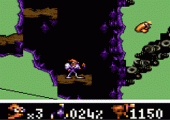
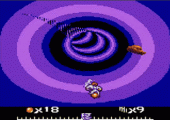
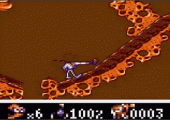
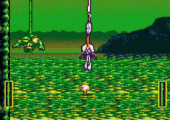
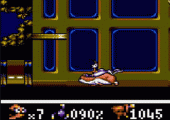
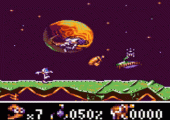
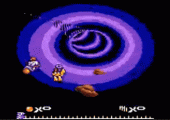
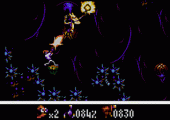

another excellent 8-bit review. Never played EJ on the Game Gear, only the 16-bit versions. Awesome game.